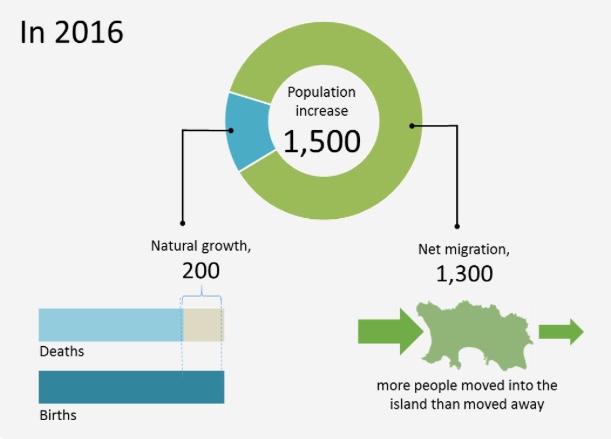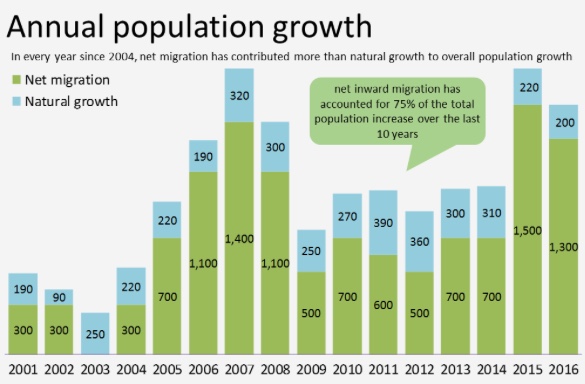

Jersey saw net migration of 1,300 people last year, way above the previous States planning figure of 325, driven by a strengthening economy.
According to the latest statistics, Jersey’s population at the end of 2016 stood at 104,200, having nearly doubled in size in the past 60 years.
The States interim population policy - which has expired, but not been replaced - targets net migration (the number of people arriving minus the number leaving) of 325 a year, almost five times lower than the actual figure.
Natural change – births minus deaths - accounted for 200 of the overall annual increase of 1,500, but migration was the key reason behind the population’s continued increase.
200 new arrivals were licensed employees and their families, while 1,100 - more than 80% - were registered workers and their dependants.
Many of these new recruits will likely stem from the construction and quarrying industry, which last year saw its headcount increase by 290 – a potential consequence of a raft of high-profile developments including the International Finance Centre and Westmount. Private sector education, health and other services, meanwhile, saw a manpower boost of 500.
Produced by the Statistics Unit, the report may make for uneasy reading for policymakers who had made their population calculations using average yearly influxes of around 325, leading to a previous estimate of an overall population of 110,700 by 2035.
If recent migration trends continue (+1,000 per year between 2013-2015), we estimate that Jersey's population would reach 128,800 by 2035 pic.twitter.com/mSGnfIcZWV
— Jersey Stats Unit (@JsyStats) June 20, 2017
But if recent trends of a yearly average influx of 1,300 people continue, Jersey could shatter this estimate by over 20,000 by 2035.
States statisticians said that the high immigration statistics may be indicative of a healthy economy, with periods of high growth tending to be coupled with an advancing population, while the years following the 2007 recession saw newcomers fall into the hundreds.
Figures showed a slight drop-off from 2015 when immigration reached an all-time high of 1,500 due to a decrease of around 200 licensed workers – a slightly unexpected turn, according to the Statistics Unit.
“When I looked at the numbers… the fact that there was a reduction in licensed net migration slightly surprised me because licenses tend to be the high-value people coming in, the ‘essential’ employees – doctors, architects, high-end finance types – and they tend to be the ones that [the government] target and try and get more of,” statistician Dan Edwards explained.
 (Source: States Statistics Unit)
(Source: States Statistics Unit)
“To see [licensed workers] fall by almost a factor of two, it raised an eyebrow in the Stats Unit… If one was growing the economy, that would be where one would push to increase,” Chief Statistician Duncan Gibaut added.
The report also reflected an overall increase of 12,000 people over the last 10 years – a dramatically different picture to that of Guernsey, which has seen figures largely flatline.
But Guernsey doesn’t follow the same population rules as Jersey, and took the radical move earlier this year to publish a list of exactly which jobs it would allow ‘non-locals’ to fill.
The news of Jersey’s continued failure to hit migration targets comes following Population Office measures announced last month, which would see businesses hit with a new ‘tax’ to help curb the Island’s growing population and ensure more employees are home-grown.

(Source: States Statistics Unit)
Speaking at the time, Chamber of Commerce President Eliot Lincoln hit out at the proposals, calling for a “sensible debate” on population to, “…help form policy across all government departments.”
Comments
Comments on this story express the views of the commentator only, not Bailiwick Publishing. We are unable to guarantee the accuracy of any of those comments.